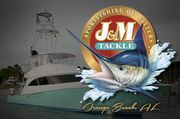
Spring Speckled Trout Fishing in Coastal Alabama
Capt. Blake Michaleski
Spotted Seatrout (Cynoscion nebulosus), or Speckled Trout as they are known to most coastal anglers in Alabama, are a prized inshore species. They are members of the drum family and are more related to a redfish than to any true trout. These predatory fish primarily forage on shrimp and small fish species such as menhaden, mullet, croakers, or smaller trout. Speckled trout, especially the larger ones, tend to roam areas vs being reliably at a spot. Trout are schooling fish with the size of the school decreasing as the average size of the fish increases. At lengths over approximately 25”, trout become solitary fish.
Speckled trout can be accessed from the beach and sandy shorelines along our bays. Wading for these fish is popular because of their tendency to roam shallow flats. This is especially true in low-light periods as the water temps continue their seasonal rise. Mornings on the beach with a 7’ medium weight, fast action rod and a handful of lures can make for some very memorable days on the water. Be aware not to “fish beyond the fish'' as oftentimes trout will run along the immediate shoreline inside the first sandbar. Often, it is not necessary to wade while beach fishing.
If fishing from a boat, you can seek out known holding areas away from those accessible by land. The ability to cover water increases your chances of finding cooperative fish. Trout move during the day. Often seeking refuge in deeper water during temperature extremes. On cooler mornings and hotter mid-day periods, you may find trout deeper. Often hanging around ledges in the 8-12ft range. As waters warm in the morning, and cool off in the late afternoon, trout can be found on the flats chasing mullet and shrimp.
Lures of all types work well but suspending twitch baits such as Mirrodines, Rapala X-raps, Slick Lures, work well for the larger fish. Popping corks with an artificial shrimp lure work well for searching open flats for the smaller schoolie trout. Live bait is favored by both the novice and the trophy hunter. Live shrimp as a great bait for many inshore species. Present them on a light wire but strong hook, such as a #2 Owner Mutu Light Circle hook. Typically, 12# fluorocarbon and a split shot weight is all that is needed. At times a heavier carolina rig may be needed but a good rule of thumb is to use as little weight as necessary. This provided for as natural of a presentation as possible. Those targeting larger fish will scale up their tackle appropriately. 20# fluorocarbon, a 4/0 light circle hook, and a bridled live croaker or mullet will catch the big ones while eliminating nuisance bites from smaller fish.
About the Business
Have a question? Ask the experts!
Send your question

